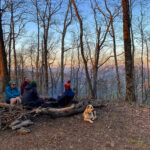While the Appalachian Trail (A.T.) is safer than most places, it is not immune from crime or problems that plague society at large.
- Stay aware of your surroundings: where you are, what you are doing, and who’s around.
- If your safety is threatened, call 9-1-1.
- Share your plans with someone at home and check in with home as often as possible.
- Do not share your plans and location with strangers, online or in person.
- Pay as much attention to your mental preparation as your gear, prioritizing developing situational awareness and concentration.
- Cell phone reception is unpredictable and, in many places, nonexistent; consider a satellite-guided messenger device for long treks.
- Carry a map and know how to read it; no batteries are required.
The A.T. is a public resource that is within a day’s drive of some of the largest cities in the U.S. and has relatively frequent road crossings/access points. You will likely meet a variety of people on the Trail from all backgrounds and walks of life. Be polite but wary of strangers and move on if something does not seem right.
Situational awareness is one of your best lines of defense against crime on the A.T., and your mental preparedness and concentration on your surroundings provide your best tool in responding to potentially dangerous situations. Here are some suggestions to minimize crime-related risk on the A.T., whether you’re on the Trail for one day or six months
If you ever feel your safety is threatened on the Trail, call 911.
Do not feel you need to decide what is or is not a crime before you call — law enforcement will make that decision. Most importantly, telling the world on social media does not count; law enforcement does not monitor Trail-related social media.
If you see something suspicious, stay safe, and tell us about it using the Incident Report form. If you are unable to call 911, notify local law enforcement as soon as possible. Note that the Incident Report does not trigger an immediate law enforcement response.
Leave your hiking plans with someone at home and check in frequently
- Establish a time you will check in upon completion of your trip, as well as a procedure to follow if you fail to check in.
- Be sure your contacts and your family know your “Trail name” if you have one.
- On short hikes, provide them with the number of the land-managing agency for the area of your hike—information available on ATC maps or found on the Internet once you identify the federal or state agency.
- On extended hikes, provide someone at home with the ATC Incident Reporting link at appalachiantrail.org/incidents. Long-distance hikers should check in regularly with folks back home and be mindful that any deviation from a set pattern will likely cause anxiety and possibly an unnecessary search.
- On extended hikes, let folks at home know when you are entering more remote areas where you may not be able to get cellphone service or even a GPS signal out for an extended period. These areas include Great Smoky Mountains National Park, the Tennessee and Virginia highlands south and north of Damascus, and most of Maine (though cell reception is spotty along the entire Trail).
Sharpen your situational awareness
Situational awareness, or staying aware of your surroundings, is one of your best defenses against danger.
- Be aware of what you are doing, where you are, and with whom you are talking.
- Knowing where you are means knowing distance to the nearest major waypoint like a road, shelter, or popular summit. While mileage can be helpful (e.g. NOBO mile 864.2), also be able to describe your location in relation to major waypoints that emergency responders may be more familiar with.
- Trust your gut (intuition), meaning that if you get a bad feeling about a person or a situation but can’t pinpoint why, pay attention to that feeling and leave the situation or area. Your gut is usually right, even when your brain can’t explain why. It is better to come off as rude than be in an uncomfortable or threatening situation.
- For long distance hikers, situational awareness includes having general knowledge of who is hiking south and north of you, and who is around when you are in town to resupply. Knowing where other hikers are that you trust can be helpful.
- Before you go, think about what could go wrong and how you will deal with it. Practice packing your gear and keep your essentials (headlamp, extra layer, wallet, medications, etc.) easily accessible in case you need to leave a situation quickly. If you carry an emergency GPS device, have it within arm’s reach at all times and know how to use it.
- Be aware that cell phones and earbuds may distract you and prevent you from seeing or hearing cues that could help you avert a dangerous situation.
- Always carry an outer layer of clothing that will protect you from wind and rain, as well as an extra snack and water in the event you must spend unplanned time in the woods during inclement weather.
- Do not camp within a mile of roads. Unfortunately, some easily accessible campsites and shelters may be used as party spots for non-hikers. Camping close to roads and trailheads can leave you vulnerable to more people than just other hikers.
- Be polite, but cautious with strangers:
- Don’t tell strangers your plans (where you plan to camp for the night, your hiking itinerary, when you are going into town, etc.)
- Avoid or get away quickly from people who act suspiciously, seem hostile or unstable, or are intoxicated.
Use extra caution if hiking alone
- You are safest with a group; neither a single partner nor a dog is a guarantee of safety.
- Do not succumb to a false sense of security when trekking with a partner – continue to maintain your situational awareness and trust your gut.
- If you are by yourself, there is no need to broadcast that you are hiking alone or give information to strangers about your hiking and camping plans.
- If you are by yourself and encounter a stranger who makes you feel uncomfortable, say you are with a group that is behind you and move on as quickly as possible. Avoid engaging with them and put distance between you. Always pay attention to your instincts about other people.
Be an Active Bystander
Reported cases of harassment are rare on the A.T. When harassment does happen, though, it can have a deep impact on the person who is the target – sometimes coloring their entire experience on the Trail. An active bystander who intervenes tactfully, shows solidarity with the person who is the target of the harassment, or even just checks in with them after the fact can make all the difference.
An important note about being an active bystander on the A.T.:
Much of the Trail is deep in the backcountry and help may be far away. Do not intervene in a situation that will put you in danger. If a situation escalates and you feel someone’s safety is at risk, move to a safe location and call 911.
Learn how to be an active bystander from these organizations:

Hikers on Blue Mountain, by Elizabeth Saetta
Use the Trail registers (the notebooks stored at most shelters)
- If someone needs to locate you, registers entries may be helpful to authorities. Sign in so that family back home will know it’s you (let them know if you have adopted a Trail name). When signing in, consider not using gender-specific names or revealing personal information that may increase your vulnerability. Leave a note, and report any suspicious activities in the Trail registers.
- Be wary of posting your location or itinerary on online journals or social media in real time. A password-protected blog or site can offer more protection.
Know that carrying firearms on the A.T. requires a lot of forethought and planning
In general, ATC discourages the carrying of firearms on the Trail for the reasons noted below. On federal lands administered by the National Park Service (NPS) and the U.S. Forest Service (USFS), possession of a firearm must be in compliance with the law of the state in which the federal land is located. Many hikers feel the carrying of firearms is unnecessary and contrary to the social nature of the Trail. Firearms can be turned against you or result in an accidental shooting and are extra weight. If you plan to carry, be sure to acquire training beforehand and mentally prepare yourself for using the firearm. Because laws related to carry and concealed carry vary by state and land unit, it’s best to contact the forest, park, or state land unit through which you’ll be passing to ensure that you are aware of the relevant laws and have acquired any necessary permits. Firearms are not permitted in post offices and NPS buildings, including visitor centers.
More information about laws pertaining to carrying firearms in various locations along the A.T. can be found here:
- Regulations regarding firearms on NPS A.T. corridor lands (with links to state statutes on firearms in the 14 states the A.T. passes through)
- ATC’s Hunting page (Safety tips for hikers and info for hunters)
Avoid hitchhiking or accepting rides
Hikers who need to get into towns are safest making arrangements beforehand and budgeting for shuttles (or ride-sharing services such as Uber or Lyft where they are available). Remember that cell service may not be available at many trailheads.
If you have to hitchhike, do not accept a ride if:
- The driver or other occupants seem intoxicated, hostile, or mentally unstable;
- The vehicle is clearly unsafe or lacks safety features;
- You just have a bad feeling, something “doesn’t add up,” or you just don’t feel quite right. Remember, trust your gut.
- If you feel uncomfortable declining a ride, make up an excuse such as waiting for your group to catch up, that you forgot a piece of gear at the last shelter/stream crossing/break spot, etc.
If have to you hitchhike, use the following tips:
- Be sure to have a partner and flag down a vehicle yourself so you can choose the vehicle and driver, not vice versa.
- Let someone you trust know your plans ahead of time (where you are hitchhiking from, where you are going, and information about the vehicle and driver if possible).
- Make a careful evaluation before entering a vehicle. Size up (visually evaluate) the driver, other occupants, and the condition of the vehicle.
- If anything just “doesn’t add up” or doesn’t feel right, decline the offer.
- Make sure you have your phone (with some battery life left), ID, and wallet on your person. Keep your pack with you at all times.
- Photograph or write down the license plate and note the make, model, and color of the vehicle.
- Avoid riding in the back of a pick-up truck as doing so is extremely dangerous if there is a crash.
Keep in mind that hitchhiking is illegal in some Trail states and carefully consider the risks you are taking. If you have a negative encounter, report it to the local police.
Reduce opportunities for theft
- Do not bring jewelry or expensive watches on the Trail.
- Hide your money and any other valuables.
- Do not leave your pack or gear unattended. If you must leave your pack or gear momentarily, leave it with someone trustworthy.
- Do not leave valuables or equipment (especially in sight) in vehicles parked at Trailheads. More tips for leaving a parked vehicle can be found on our Parking, Shuttles & Transportation page.

Report an incident
While the Appalachian Trail is a relatively safe place to visit, that does not mean that there are no potential dangers while you are hiking or camping. If you see something, say something — this will help us keep the A.T. as safe as possible for Trail visitors.




